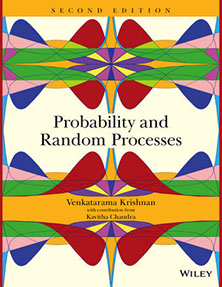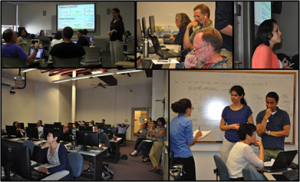Center for Advanced Computation and Telecommunications

 This book examines the topics of applied mathematical functions to problems that engineers and researchers solve daily in the course of their work. The text covers set theory, combinatorics, random variables, discrete and continuous probability, distribution functions, convergence of random variables, computer generation of random variates, random processes and stationarity concepts with associated autocovariance and cross covariance functions, estimation theory and Wiener and Kalman filtering ending with two applications of probabilistic methods. Probability tables with nine decimal place accuracy and graphical Fourier transform tables are included for quick reference. The author facilitates understanding of probability concepts for both students and practitioners by presenting over 450 carefully detailed figures and illustrations, and over 350 examples with every step explained clearly and some with multiple solutions.
This book examines the topics of applied mathematical functions to problems that engineers and researchers solve daily in the course of their work. The text covers set theory, combinatorics, random variables, discrete and continuous probability, distribution functions, convergence of random variables, computer generation of random variates, random processes and stationarity concepts with associated autocovariance and cross covariance functions, estimation theory and Wiener and Kalman filtering ending with two applications of probabilistic methods. Probability tables with nine decimal place accuracy and graphical Fourier transform tables are included for quick reference. The author facilitates understanding of probability concepts for both students and practitioners by presenting over 450 carefully detailed figures and illustrations, and over 350 examples with every step explained clearly and some with multiple solutions.
 Vibes and Waves in Action, an NSF GK-12 project at CACT held a novel workshop for high school teachers on implementing Blended Learning in their teaching environment. In this 3-day workshop, teachers: (1) Learned to create lesson plans for the blended learning model of teaching, (2) Understood how to find and use a range of existing resources for blended learning activities and online materials to create the optimal learning experience for students, (3) Gained an overview and saw examples of blended learning template lessons on e-learning platform (4) Created their blended learning lessons that will be implemented in the coming school year. Examples of created lessons can be viewed on http://vibesandwaves.org.
Vibes and Waves in Action, an NSF GK-12 project at CACT held a novel workshop for high school teachers on implementing Blended Learning in their teaching environment. In this 3-day workshop, teachers: (1) Learned to create lesson plans for the blended learning model of teaching, (2) Understood how to find and use a range of existing resources for blended learning activities and online materials to create the optimal learning experience for students, (3) Gained an overview and saw examples of blended learning template lessons on e-learning platform (4) Created their blended learning lessons that will be implemented in the coming school year. Examples of created lessons can be viewed on http://vibesandwaves.org.
 At the 169th Meeting of the Acoustical Society of America, a special session Acoustofluidics: Interaction of Acoustics and Fluid Dynamic Phenomena Cochaired by Charles Thompson and Max Denis convened. The topics included Acoustic tweezers, steady streaming, and surface acoustic wave microfluidics. The following were invited Speakers: James Friend (University of California-San Diego, La Jolla, CA), Tony Jun Huang (The Pennsylvania State University, University Park, PA), Sadhal Satwindar (University of Southern California, Los Angeles, CA), Charles Thompson (University of Massachusetts Lowell, Lowell, MA), Siew-Wan OHL (Institute of High Performance Computing, Fusionopolis Way, Singapore).
At the 169th Meeting of the Acoustical Society of America, a special session Acoustofluidics: Interaction of Acoustics and Fluid Dynamic Phenomena Cochaired by Charles Thompson and Max Denis convened. The topics included Acoustic tweezers, steady streaming, and surface acoustic wave microfluidics. The following were invited Speakers: James Friend (University of California-San Diego, La Jolla, CA), Tony Jun Huang (The Pennsylvania State University, University Park, PA), Sadhal Satwindar (University of Southern California, Los Angeles, CA), Charles Thompson (University of Massachusetts Lowell, Lowell, MA), Siew-Wan OHL (Institute of High Performance Computing, Fusionopolis Way, Singapore).
 Helicopters are underactuated, highly nonlinear systems with significant dynamic coupling that needs to be considered and accounted for, during controller design and implementation. Most reliable mathematical tools for analysis of control systems relate to modern control theory. Modern control techniques are modeled-based since the controller architecture depends on the dynamic representation of the system to be controlled. Therefore, the flight controller design problem is tightly connected with the helicopter modeling.This book provides a step-by-step methodology for designing, evaluating and implementing efficient flight controllers for small-scale helicopters.
Helicopters are underactuated, highly nonlinear systems with significant dynamic coupling that needs to be considered and accounted for, during controller design and implementation. Most reliable mathematical tools for analysis of control systems relate to modern control theory. Modern control techniques are modeled-based since the controller architecture depends on the dynamic representation of the system to be controlled. Therefore, the flight controller design problem is tightly connected with the helicopter modeling.This book provides a step-by-step methodology for designing, evaluating and implementing efficient flight controllers for small-scale helicopters.